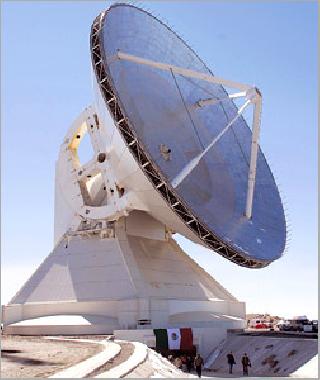
The Large Millimeter Telescope at a height of 4,580 meters on the summit of Sierra Negra in Mexico.
SIERRA NEGRA, MEXICO (AFP): A giant telescope, 164 feet across, will this year start unravelling mysteries of the birth and death of galaxies up to 14,000 light years away, from atop a Mexican volcano.
Resembling a massive white satellite dish, the Large Millimeter Telescope will be the largest and most sensitive single-aperture telescope operating at its range.
It sits at a height of 4,580 meters on the summit of Sierra Negra, an extinct volcano in the central state of Puebla, which lies alongside Mexico's highest mountain, the snowy-peaked Pico de Orizaba.
Built at a cost of 115 million dollars, it is the world's largest telescope operating in millimeter waves (mainly from 0.85 to three millimeters), which allow it to capture radiation from space, the coldest regions of the universe, molecular clouds or planetary formations.
After a 12-year construction process and a test run in 2008, it is due to start research operations at the end of this year.
"We'll make the first observation as part of an investigation," said Raul Mujica, a researcher from the joint project between the University of Massachusetts and the Instituto Nacional de Astrofisica, Optica, y Electronica (INAOE) in Mexico.
Three quarters of the investment is from the INAOE and one quarter from the US university, in a division to be mirrored in the observation time for each team of researchers, said Jose Guichard, director of INAOE.
The researchers admit they are unlikely to achieve concrete results in "earthly terms" in the short term, but that in the future the telescope will help advances in fields from telecommunications to medicine.
"We'll explore theories of the origin of life, like those which lead to the birth of a comet. We'll study comets, their chemical composition, before they catch fire near the ground," Mujica said.
 Previous Article
Previous Article Next Article
Next Article











The Indian Air Force, in its flight trials evaluation report submitted before the Defence Ministry l..
view articleAn insight into the Medium Multi-Role Combat Aircraft competition...
view articleSky enthusiasts can now spot the International Space Station (ISS) commanded by Indian-American astr..
view article